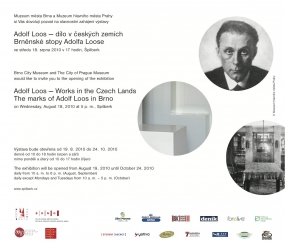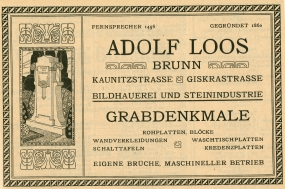The exhibition Traces of Adolf Loos in Brno will take place in the Brno City Museum in Špilberk Castle from the 19th August to 31st October. This exhibition and publication project will thematically build upon the exhibition Adolf Loos – Works in the Czech Lands which was recently organised in the City of Prague Museum. The Prague exhibition will also be on display in Brno, Loos's home town, along with the new exhibition.
After the successful restoration work on Villa Müller in Prague, completed in the year 2000, the Adolf Loos Study and Documentation Centre initiated its activities directly in the Villa. The results of their ongoing research work were presented in Pilsen at the international symposium Work and Reconstruction organised in 2003 on the occasion of the 70th anniversary of the death of Adolf Loos. The several-year-long systematic research culminated with the exhibition Adolf Loos – Works in the Czech Lands whose author, including an extensive catalogue, was the curator of Villa Müller, Maria Szadkowska. The co-author was the American researcher Leslie van Duzer. Dagmar Černoušková contributed to the research on the work by Loos in Brno and in Hrušovany u Brna with considerations regarding the work of Loos's father, the Brno sculptor and stone mason Adolf Loos Sr.
The person and work of one of the most famous native sons of Brno, the architect Adolf Loos (10th December 1870 Brno – 23rd August 1933 Kalksburg, Vienna), has been of interest to several generations of art historians and architecture theoreticians. Loos's explorations outside the branch of architecture, his friendly contacts with the Viennese intellectual and artistic Bohemian circles, his interesting clientèle and first and foremost his unceasing exploration of “a culture of everydayness” continue to fascinate scholars in the areas of sociology, literary criticism, theatre studies, German studies, etc.
The architect Adolf Loos ranks among the leading figures in classic Modernism in architecture along side of F. L. Wright, Le Corbusier and Mies van der Rohe. His theoretical views were formulated prior to World War I. His essay Ornament and Crime (1908) is considered the most significant text in architecture theory and culture of the 20th century. Loos's most important realised buildings and interiors include Café Museum (1899) and the American Bar (1908) in Vienna, Villa Karma in Switzerland (1903-06 and 1909-12), the Goldmann & Salatsch building on the Michaelerplatz in Vienna (1909-11), the Viennese Steiner (1910), Scheu (1912-13), Mandl (1916), Strasser (1918-19), Rufer (1922), Moller (1926-27) houses, the house for the poet Tristan Tzara in Paris (1925-26), the unrealised design for a house for Josephine Baker (1927) and Villa Müller in Prague (1928–30) which is viewed as the most advanced of his works.
Adolf Loos is generally considered to have been an Austrian, in light of the fact that the majority of his life and work is linked with Vienna. His crowning work, however, Villa Müller was created in Prague in the capital of Czechoslovakia whose citizen he became after the dissolution of the Austro-Hungarian monarchy.
Adolf Loos executed a number of designs in the Czech Lands and these over the course of two stages (1907–1908 and1928–1933) working out of Pilsen where he mainly designed interiors for flats. In-between there followed a number of designs and realisations in Brno, Prague as well as elsewhere in Moravian and Bohemia. The crowing work of his career became the house for the family of Dr. František Müller in Prague. Loos fully made use of the concept of arrangement of the living space in the spirit of the so-called 'Raumplan' with Villa Müller. This was based on space and height differences for the particular functional zones mutually connected by short staircases.
Loos's work in Brno always remained somehow half done, in a similar manner as with his relationship with his home town. His loving memories of his father with his stone work shop, where he discovered the world as a young boy, were overshadowed by his hatred for his strict and rigid mother. After unsuccessful studies in Jihlava, Melk and Liberec, he finally graduated from the German applied arts secondary school in Brno where his schoolmates included Josef Hoffmann, Leopold Bauer and Hubert Gessner, later graduates of the Viennese Academy of Otto Wagner and consequently renowned figures in the Viennese and European architecture scene.
In all probability due to a misunderstanding between the architect and the commissioner, Loos's first project for a Brno client, Karel Herold, came to an end prematurely. He undoubtedly met with greater understanding in connection with Viktor Bauer who he designed a villa for and perhaps also the main factory building of the sugar refinery in Hrušovany u Brna. Both men were definitely linked by their contacts with Viennese cultural circles. It was certainly at Loos's instigation that Viktor Bauer had a portrait carried out by the architect's friend Oskar Kokoschka in 1914. He was also painted, five years later, by Egon Schiele. In the middle of the 1920s, Loos worked on adaptations to Bauer's château on the grounds of his Old Brno sugar factory which had burned down (the so-called château at the exhibition grounds). Although it was not definitively completed, it is at present practically the only consistent realisation by Loos in Brno. His promising developing cooperation with the magazine Bytová kultura (Housing Culture) and Jan Vaněk's United Works of Decorative Art factories in Brno also came to a close prematurely. Loos's final work in Brno, the Jordan House, only remained in the phase of a conceptual study having apparently fallen through due to the small-mindedness, lack of understanding and state of insolvency of the commissioner.
The Brno celebrations on the occasion of the 100th anniversary of the birth of Adolf Loos, initiated by the architect František Kalivoda with a reference to Loos's roots in Brno, also failed to come to fruition. This ambitious tribute to this remarkable figure in the history of culture at the end of the 19th and first third of the 20th century was to have been enhanced by the personal participation of the still living Elsie Altmann-Loosová and Oskar Kokoschka. An international conference on protection of monuments of Modern architecture was also to have been organised parallel with the celebrations in Brno in December 1970. In the end all of the activities were carried on a much smaller and more modest scale. Kalivoda's vision of establishing 'an Adolf Loos Prize' in order to support and award the finest students and graduates from the Brno architecture faculty has failed to meet with a response even up until the present day.
The subtitle of the text by Dagmar Černoušková from the catalogue to the Prague exhibition, Traces of Adolf Loos in Brno was chosen by the authors of the Brno concept of the exhibition, Jindřich Chatrný and Dagmar Černoušková, as its central motif. The publication accompanying the exhibition will have the same name. The books contains a more detailed summary of Loos's work in Brno and Hrušovany u Brna, as well as chapters dedicated to the famous architect's father, his cooperation with Jan Vaněk and the initiative of František Kalivoda from 1970. It serves to fill in gaps regarding the roots and work of Adolf Loos connected with his home town. Texts which could not be published to such an extent in the catalogue for the Prague exhibition are accompanied by reproductions of up until now unknown sources, documents and photographs from both public and private archives.
The author of the introductory text is Markus Kristan, curator of the architecture collection in the Albertina Museum in Vienna which houses the papers and legacy of Adolf Loos. The author of the text dedicated to traces of Brno in the work of Loos's students is Iris Meder who has an ongoing interest in Modern Central European architecture from the circle of Adolf Loos and Josef Frank.
This publication is also being released upon the occasion of the 140th anniversary of the birth of this one of the most renowned Brno natives.
Jindřich Chatrný and Dagmar Černoušková


Advertisement for the workshop of Adolf Loos Sr., directory for the City of Brno 1923

Adolf Loos Sr., medallion with Plato, 1862, Janáček Academy of Music and Performing Arts in Brno; photo Barbora Roučková, 2010

Adolf Loos, drawing of Jaroslav Král, Bytová kultura (Housing Culture), volume I, 1925

Adolf Loos (?), main factory building of the sugar refinery in Hrušovany u Brna, 1916-1922; photo Dagmar Černoušková, 2004

Adolf Loos, villa in Hrušovany u Brna, 1914; photo Bohumil Samek, 1960s (Brno City Museum)